
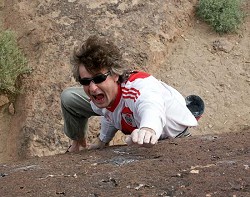
Kevin Thaw is a bloody good climber. From first ascents of Gritstone E9's to redpoints of F8b+ sport routes in America, Kevin has experienced the whole spectrum of rock climbing. However it is perhaps in the bigger mountains where Kevin's real expertise lies. He's climbed Everest (of course), various hard routes in Patagonia (including the first free ascent of Fitzroy's West face), several Alaskan test pieces, Alpine ED3's and a bit of everything in between. Here he looks at a few ascents that inspired him in 2008.
You can read more about Kevin on his website: KevinThaw.com
End of year: Super Alpine 2008 by Kevin Thaw
Alpine climbing: Gaining passage over severe and fickle terrain with a bare minimum of equipment. Does it offer an unequivocal balance in a hectic world? I certainly remember landing in many situations as a result of convincingly lying to myself, by this I guess I mean:
If full knowledge of how one will feel and the dangers to be encountered are no secret, then, Why?
Could it simply be pressing into the unknown on a challenging journey? Perhaps you're the rarer breed, into perverse flagellation all because you love climbing when tired; maybe you even love objective danger? Either way, the ability to mentally package the 'last time' so incredibly neatly that emotions are completely erased is an asset. Ready for another round?
I feel it an impossible task to arbitrate a narrow spectrum of ascents from the many triumphant teams climbing fresh routes upon savage faces: Significant outings in grander ranges? For the sake of argument I'll make it simple by including only summiting teams. I know with Alpine endeavours that the journey is always, unequivocally the most important; the absolute meat o' the matter. With that said, it is always nice to conclude an outing on the highest possible nub. Really I'm just trying to make my task easier!
Waffling done, we can begin with the Southern Andean wind raked towers of Patagonia. Personally, I find it a most marvellous locale to engage the Alpine challenge. Not exactly grandiose in elevation but I haven't found myself swept away - laid out - legs in the air - on my back - wondering what the f*@# just happened - following a Himalayan blast of wind!
Down South
On fierce days the jet stream drops to graze and scour the valley beneath the Torres & Fitzroy's monumental spikes. Beautiful, compelling and quick to imprint vivid images, hopefully not of life strapped to the side of a steep peak, blending with those of being tethered to a runway, basking in take-off jet wash. Even on good days every hour feels borrowed, it's hard not to be eternally looking over one's shoulder for a rolling cloud-wall, or similar inbound signs over the Hielo continental (the continent's icecap).
If I'm not selling it, the climbing certainly would. As clean as Yosemite's soaring features and arguably the most aesthetic peaks anywhere. I feel one ridge-line in particular embodies this, Punta Herron, Aguja (needle) Standhardt, Torre Egger & Cerro Torre.
Ice creeps all the way down these angular peaks after storms, retreating back to form formidable summit mushrooms during better conditions. Italian Cesar Maestri was so drawn to Cerro Torre he hauled a petrol powered compressor up the SE ridge and impressive capping headwall in order to leave inevitable drilled trinkets much of the way. The Compressor (what's left of it) still resides a rope length below the summit, a rope length that he chopped the bolts from ( Reinstated by James Bridwell Esq). An unusual approach you may think, especially after he'd already climbed the peak with Toni Egger a decade prior... The technically demanding north face of the Torre has subsequently seen many probes and a valiant effort from Austrians Tommy Bonapace & Toni Ponholzer. These attempts did nothing to diminish the doubt stemming from the moment Maestri stumbled alone from the base following Toni Egger's unfortunate demise during descent.

The Torre Traverse
Cerro Torre was the final hurdle for Rolando Garibotti (36) and Colin Haley's (23) journey: The three Torres are certainly monumental and traversing them in a continuous Alpine push is little short of iconic. Four summits were encompassed during this enchainment: commencing with Cerro Standhardt via Exocet ('88 Jim Bridwell, Greg Smith y Jay Smith 5.10, WI 6) rappel descent down the south face onto Punta Heron ('91, Ermanno Salvaterra, Adrianno Cavallaro & Ferrucio Vidi ED, 6a+, 90º), Torre Egger ('05 Tomas Huber & Andy Schnarf route) and of course Cerro Torre via the upper section of Arca de los Vientos ('05 Salvaterra, Alessandro Beltrami and Rolando Garibotti) then connecting with the final section of the west face's Ferrari route.
January 21–24, 2008. On January 21st the pair climbed Standhardt, rappelled to the col de sogni and immediately headed up Heron. Slow mixed conditions slowed this route with their first bivouac just below Heron's summit mushroom. Herron for Jan 22nd's breakfast then over the Egger with the second bivouac in the Col of Conquest. They stopped early for shelter, hiding under a jutting prow from the collapsing Torre mushroom and deteriorating north face. The night of the 23rd saw them above a rotten rime choked Arca de los Vientos. Steep tunnelling kicked off the final day to summit the Torre and finally descend down Maestri's Compressor route.
Read the full UKC feature: An Interview with Rolando Garibotti about the Torre Traverse
Rolo wrote the following history of intent on the Traverse:
This traverse is the brainchild of Italians Andrea Sarchi, Maurizio Giarolli, Elio Orlandi and Ermanno Salvaterra, who tried it on several occasions in the late '80s and early 1990s. In 1991 Salvaterra, together with Adriano Cavallaro and Ferruccio Vidi, managed to climb to Punta Herron, completing what is likely the first ascent of the peak. Salvaterra climbed Herron via a new route on the north ridge, the aesthetic Spigolo dei Bimbi. In early 2005, German Thomas Huber, together with the Swiss Andi Schnarf, completed the Standhardt to Egger traverse. Having only intended to climb Standhardt via Festerville, they decided on the summit to continue on toward Egger, and moving light and fast completed this section of the traverse in 38 hours round-trip, and descended via Egger's Titanic route on the East Ridge. In late 2005, Salvaterra, together with Alessandro Beltrami and Rolando Garibotti, solved the last remaining puzzle of the traverse when they climbed Cerro Torre from the north via a new route, El Arca de los Vientos. Torre Traverse remained elusive due to inevitable weather difficulties yet Garibotti comments that it involved little 'true' extreme climbing, difficulties never exceeded 5.11 or A1.
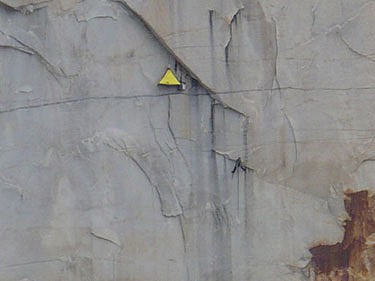
Taste The Pain
At the Southern end of the Continental Icecap lie Paine's walls and towers. Escudo's colossal, seemingly blank 4000ft East face overlooks the Valle Silencio and across at the three Torres del Paine. This fine locale face saw the California developed craft of hard aid climbing applied by Sacramento's Dave Turner. Encompassing a lonely New year celebration Dave enjoyed a solitary 'capsule style' quest of thirty four days, VII, rain, sleet, snow, 5.10, A4+ on his new route “Taste the Pain”.
Thanks go to Mike Rayner for the photo: mytb.org/mrayner.
No stranger to steep time alone Dave has soloed numerous El Cap lines including a couple of firsts. His journey south was aided by an American Alpine Club grant.
Dave's line is described as pretty central, to the left of Chris Breemer, Brad Jarret, and Christian Santelices' '95 ascent “The Dream” VII 5.10 A4+.

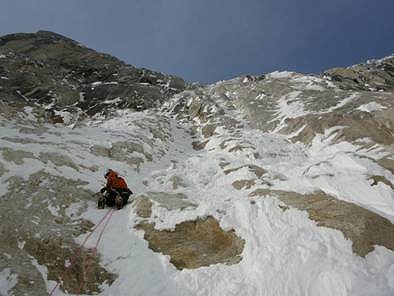
Way Up North
At the opposite end of the Americas, Fumitaka Ichimura, Yusuke Sato, and Katsutaka Yokoyama of Japan answered a trans Pacific calling to the deep Alaskan valleys. My guess is their psyche must have been brimming as they lifted off from Talkeetna, shuttled above the tundra and sloughed the single engine air taxi onto Denali National Park's Buckskin Glacier. Just to warm up for the big plan! Photos Courtesy of Yusuke Sato.
April 18th, without wasting a moment they steered straight toward the Bear Tooth's north east face. They made a bee-line for a technical granite buttress from a couloir dividing the peak from Moose's Tooth. Over two days they established an Alaska 6, (ED4) 5.10a AI5 M7R A1+, quite a tally for the three and a half thousand stout feet of technicalities beyond the access couloir. Still merely an initial foray/warming up for the self dubbed “Girigiri boys” and their psyche hadn't even been dented. Call in air support, re-locate to the Kahiltna and further the warm up with a quick dash up Mt Hunter's Classic (Alaska 6 AI6 M5 5.8 A2) “Moonflower Buttress”. Almost a steep mile of superb mixed climbing on mainly good granite.
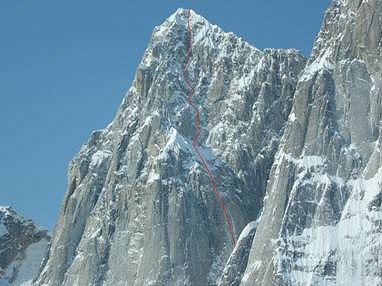
2700m for the Slovak line plus 2300m for their South Face “access”!
Unfortunately not all news from the North was good. From Alpinist Newswire: Two Japanese Climbers missing on Denali. They planned to climb the Cassin following a traverse over Kahiltna Peak. For unknown reasons they abandoned the traverse and repositioned themselves on the north-east fork of the Kahiltna. It is thought they began around May 14th, Yokoyama sighted tracks on the upper portion of the Cassin but couldn't be sure if they were made by his friends, Yuto Inoue and Tatsuro Yamada.
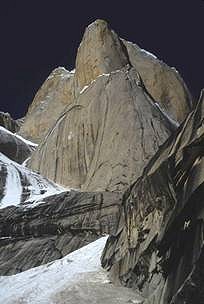
Himalayan conquest
A Himalayan conquest is very much like heading out into your local winter, but with the length upped a tad, plus the debilitation handicap added from thinner air. With that said, whatever the climbing medium, one should never ignore the stake. K2 proved a sad reminder of the environments power & fickle character. The tragic end to eleven lives unfortunately enforces the idea that we merely steal time in high mountains, so many factors bend the rational of even travelling there. (UKC News Item)
Great Trango
In '84 Hans Christian Doseth, Dag Kolsrud, Stein Aasheim and Finn Daehli stepped Himalayan Big-Wall climbing into a new era with their ascent of the renown Great Trango Tower. Just to reach the headwall required twenty days on the wall and stretched their supplies to the limit: Dag Kolsrud & Stein Aasheim took the noble decision to descend allowing Doseth/Daehli to remain in the wall a further week and continue their ascent all the way to the summit. The lead pair sadly fell to their deaths during descent.
(Photo by John Middendorf Bigwalls.net.)
This year's Norwegian team Rolf Bae, Bjarte Bø, Sigurd Felde, and Stein Ivar spent twenty seven days, climbing all the way to Great Trango's 20,443ft summit on the east end of it's cock-comb crest.
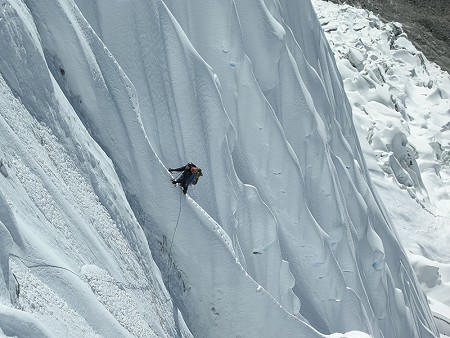
Kang Nachugo and Annapurna
Nepal saw several noteworthy additions, certainly Alaskan practitioners Joseph Puryear and David Gottlieb's ascent of Kang Nachugo, a previously unclimbed peak (6,735 meters) in the Rolwaling region of Nepal. (UKC News Item)
[EDITOR'S NOTE: We have had information that this peak may have been climbed previously. We are currently researching this possibility.]
Kang Nachugo Video:
Kang Nachugo Summit from Joe Puryear on Vimeo.

Ueli Steck and Simon Anthamatten deserve kudos for foregoing their bid on Annapurna's South face to answer a cry for help from a nearby Spanish climber, his compadre had only enough strength to deal with his own descent and both were suffering from time aloft. Ueli & Simon had already acclimatised in the Khumbu region with the first ascent of oft tried North face of Tengkampoche (6500m). The pair climbed the line over four days straight from arrival then immediately on to Annapurna via Lukla & Kathmandu.
As with others I mentioned earlier: For the sake of argument I'll make it simple by including only summiting teams, I know with Alpine endeavours that the journey is always and unequivocally the most important factor: The absolute meat o' the matter, with that said it is always nice to conclude an outing on the highest possible nub. If only for the sake of argument?
Makalu: New Route, Kangchungtse
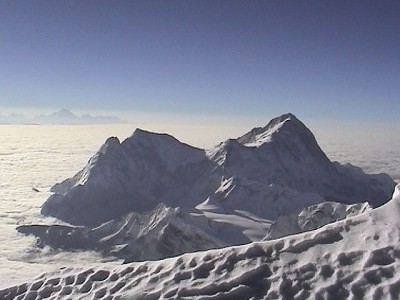
Saturday 10-18-08 Vince Anderson via satphone:
On Thurs., Oct. 16, Steve, Marko and I hiked up to C2 (ca. 6,700 m.) on the std. route of Makalu with the intention of staying a few nights for further acclimatization and possibly to climb Kanchungtse (Makalu 2 - 7,600 m.). Steve's cough had not abated so he decided to just rest at C2 while Marko and I climbed. We wanted to try a route on the unclimbed west face (a previous attempt had ended on the ridge, just shy of the summit).
We woke early the following morning to clear skies, light winds and very cold temps. We left Steve and camp at 7:00 a.m. and approached the base of the face in just under two hours. My feet were so cold that I had to stop in the bergschrund, take off my boots and re-warm them in my hands.
We started up the broken ice and rock face just as the sun poked out at us. We started out simul-climbing on moderate terrain until we ran out of ice screws. After a few of these, the terrain steepened and the climbing became more interesting with the occasional mixed step. Now, we climbed it one slow pitch at a time. We stayed in the sun most of the day which helped take some of the sting out of the biting wind. Sometimes, it would sound like a freight train as it blasted over the ridges above.
The climbing kept getting harder as we got higher. Above 7,000 m. the altitude began taking its toll as well, forcing us to progress at a snail's pace. After about a dozen pitches came some reprieve: snow. We were able to climb easily, if slowly, up for 100 m. towards the top in the amber light of late afternoon. We knew we would be benighted but not where. It seemed like we had it in the bag if only the snow would just end. It did, but not onto easier ground as we had hoped for. Above us, lay steep rocky steps and dark, menacing clouds. Marko led through one step only to be confronted with another one. It was beginning to feel as if it would never end. In the final light of the day, I turned around to catch a glimpse of a truly beautiful sunset behind Everest and Lhotse, just twelve miles distant.
Darkness descended and with it, cold. We were still going up. Long out of water and unable to eat any more food without it, we were exhausted from the long day out in the cold, the hard climbing and the high altitude. We were now at 7,600 m. (ca. 25,000 ft.) and in the dark. The cold crept in. I paid out the last of the rope, disassembled the anchor and started climbing again. After a seemingly endless progression of four breaths for every single step, the rope led me up over the highest point then down a short ways to a small flat where Marko was belaying. We said nothing, exchanged bear hugs and, without any photos or celebration, started down.
Unbeknownst to us, others, including Steve, had been tracking our progress from below not without some consternation due to the late hour of our summit, the high winds and gathering clouds. For some reason (dehydration?), my eyesight in my left eye was completely blurry. I was having great difficulty seeing. Marko led down. All I had to do was follow his footprints in the snow. In an hour and a half, we had made it down to Makalu La, the large pass separating Makalu from Kangchungtse. There, we intersected the std. route on Makalu and followed it down to our camp. We arrived at 11:00 p.m. to Steve eagerly awaiting us with hot drinks and soup.
The weather that had been threatening did come in that night with high winds and light snow. It ended up being a good test of our lightweight tent as we woke covered in a light dusting of snow inside the tent! It made for a long, sleepless night. The following morning, Saturday, we all packed up and descended to base camp.
Vince
From: www.thecleanestline.com
There we have it. A round up of some fantastic ascents from 2008. Stay safe, enjoy the mountains and have fun.
Best of luck to all in 2009 - Kevin Thaw
Sources:
American Alpine Journal - Climbing in Patagonia.freeservers.com - Supertopo.com - Rolando Garibotti - Dave Turner - Climbing.com - The Cleanest Line.com - John Middendorf / Bigwalls.net - Yusuke Sato - Alaska Climbing - ClimbandMore.com









Comments